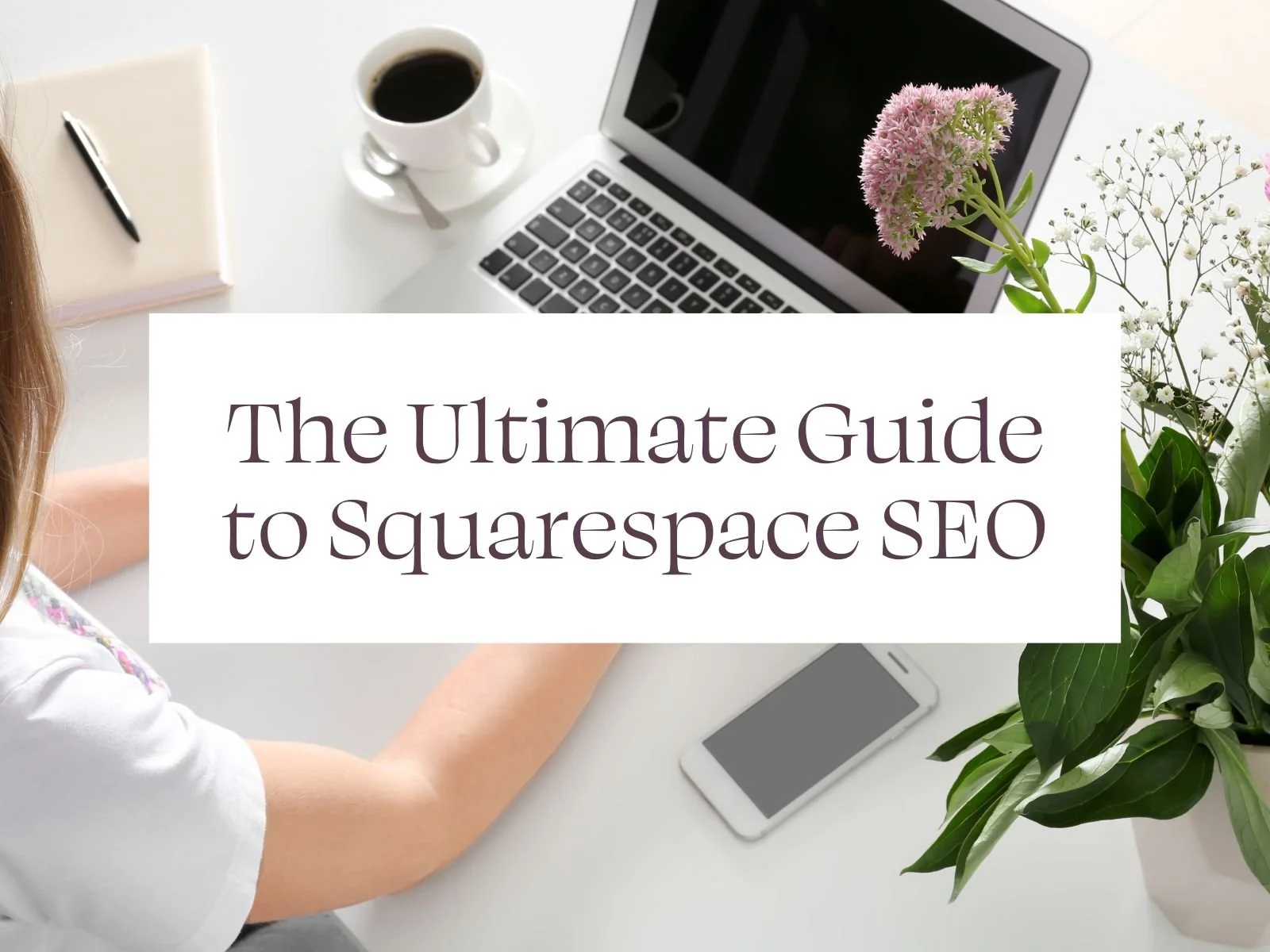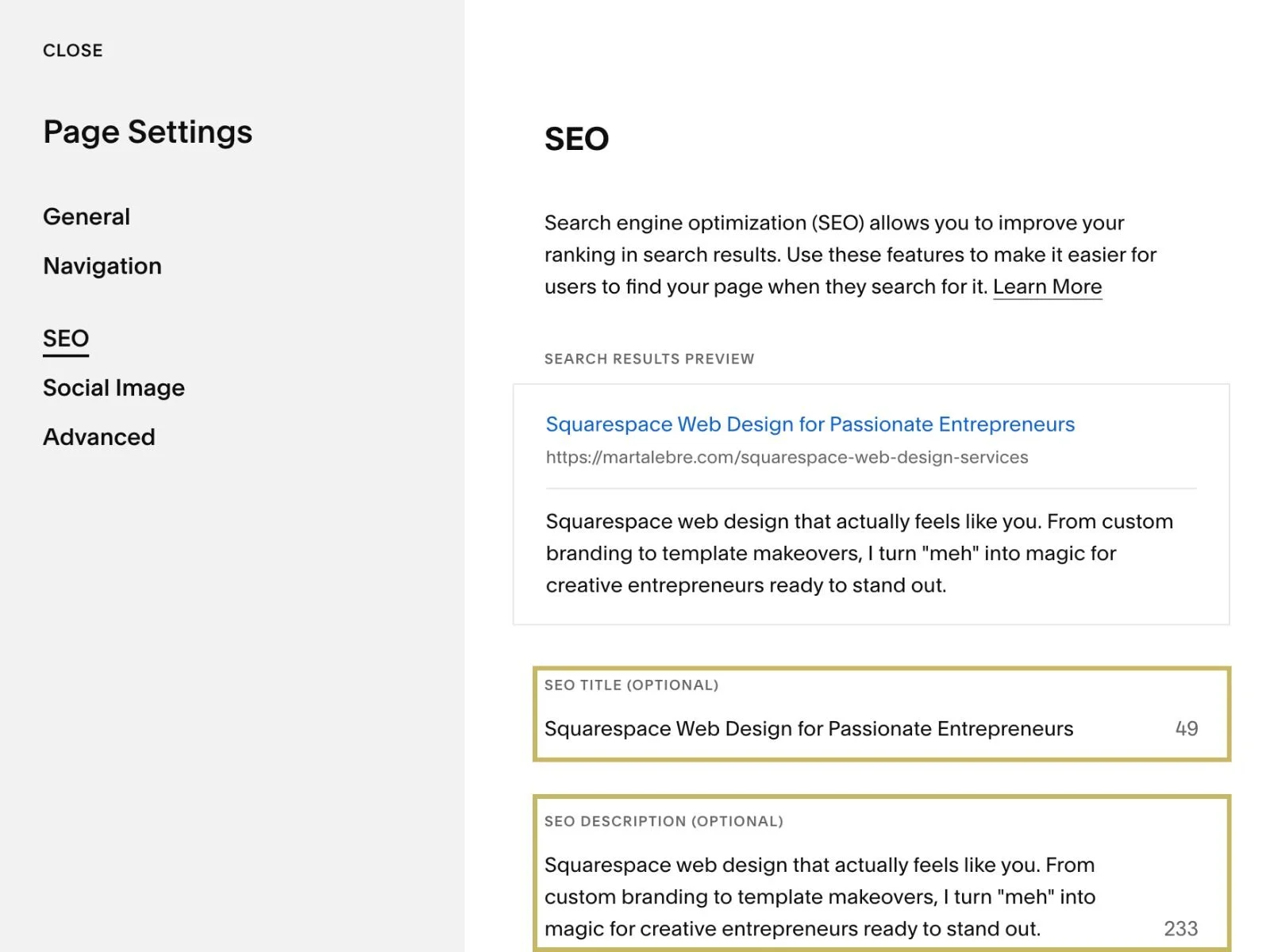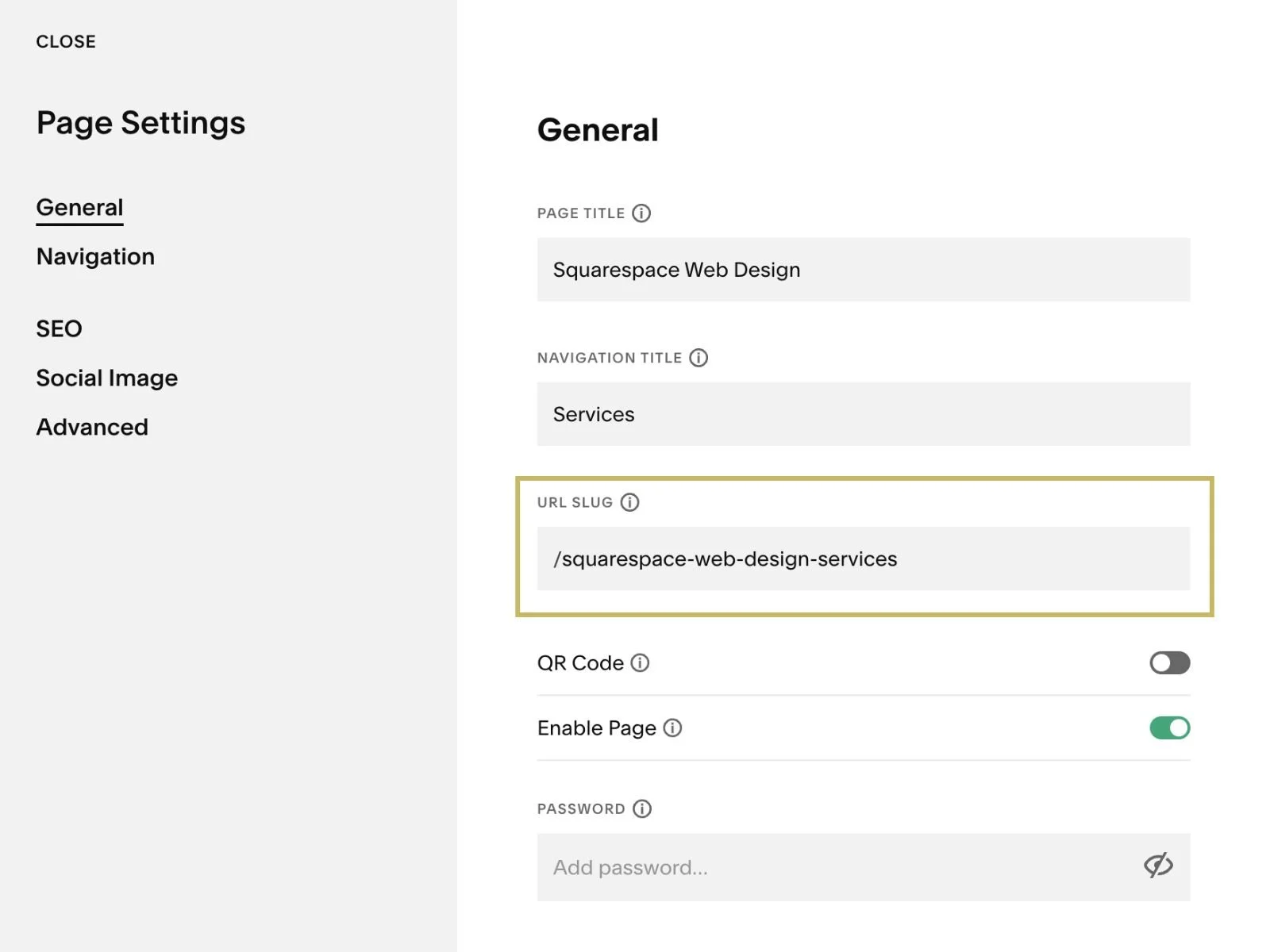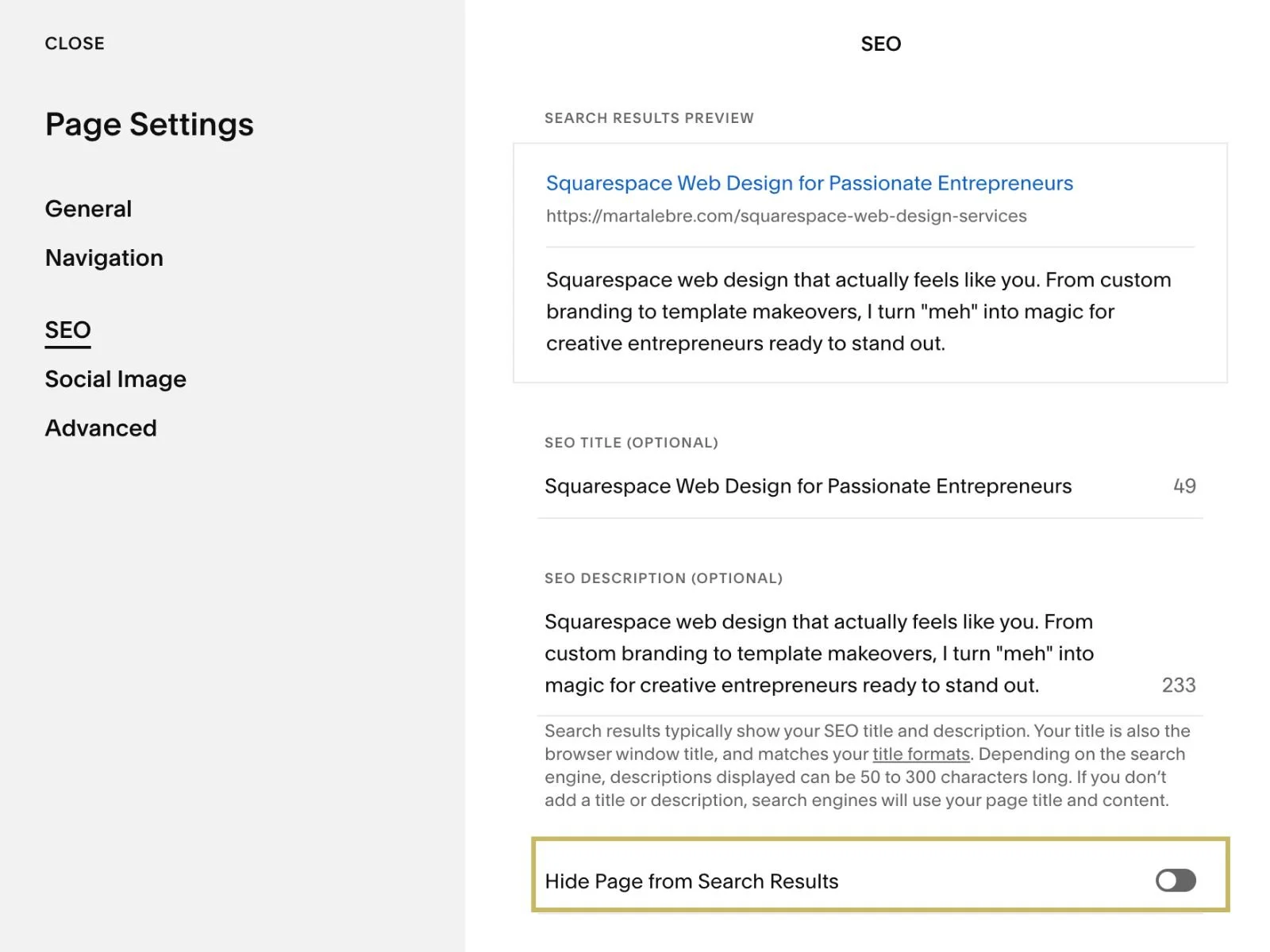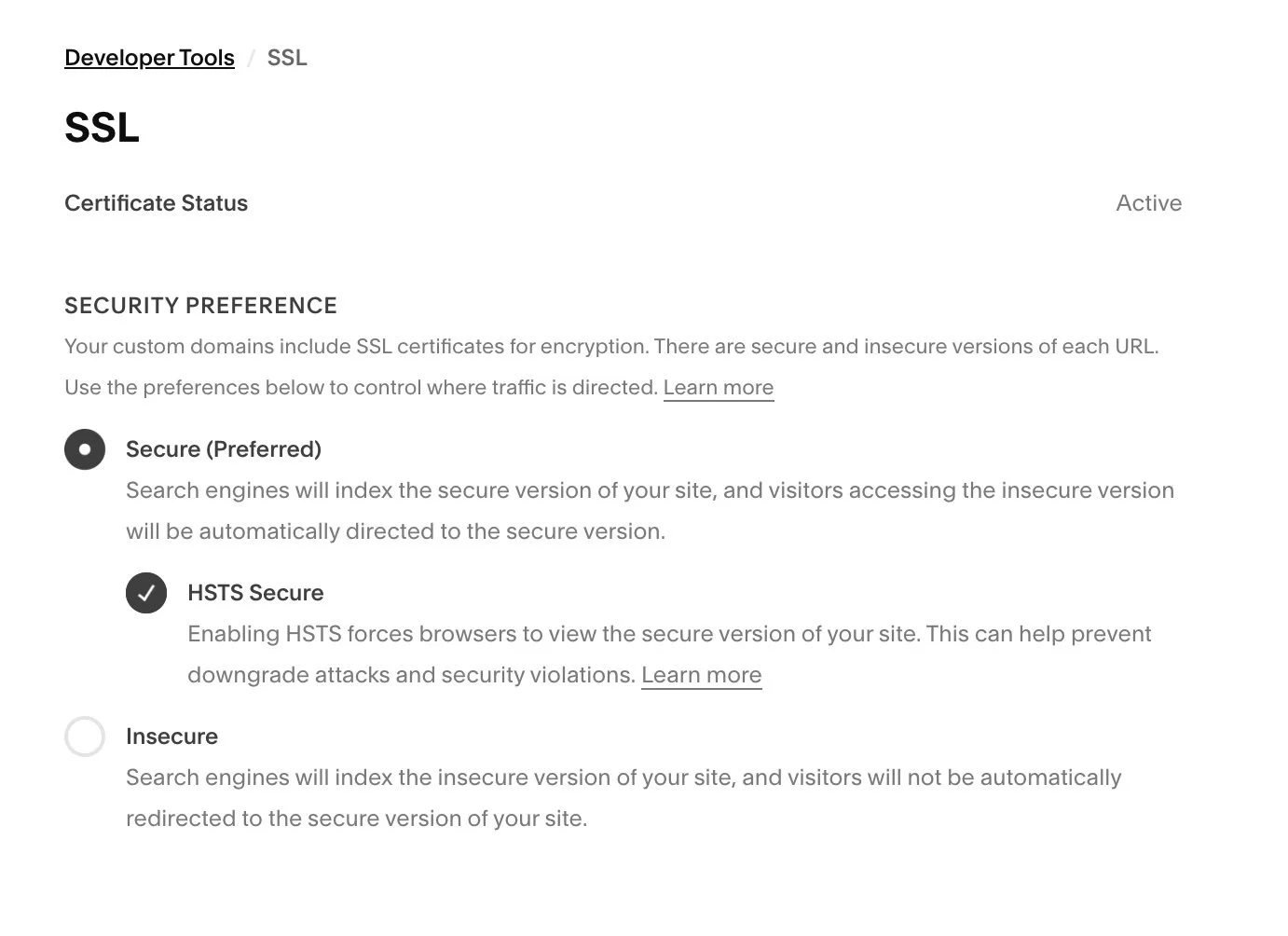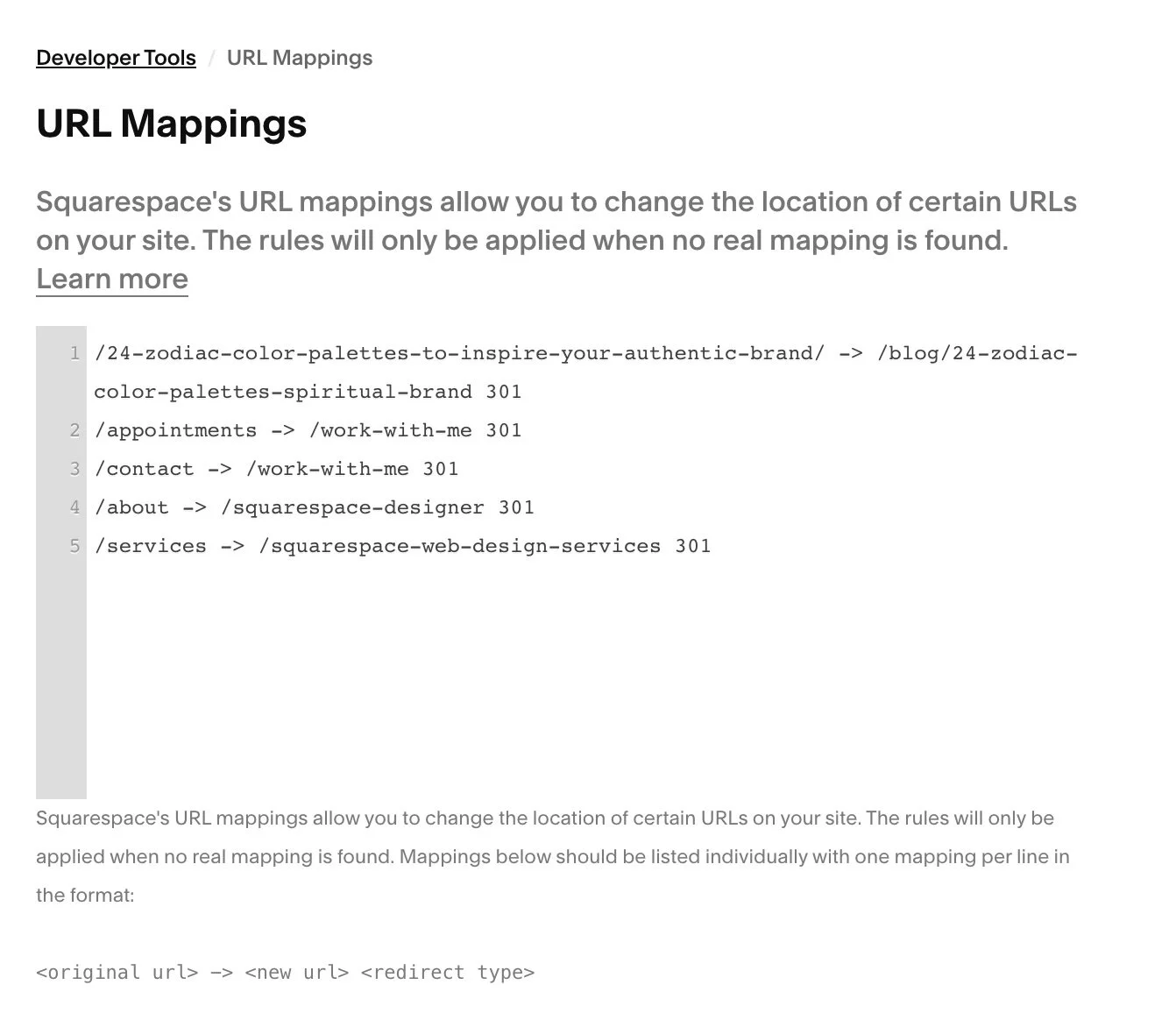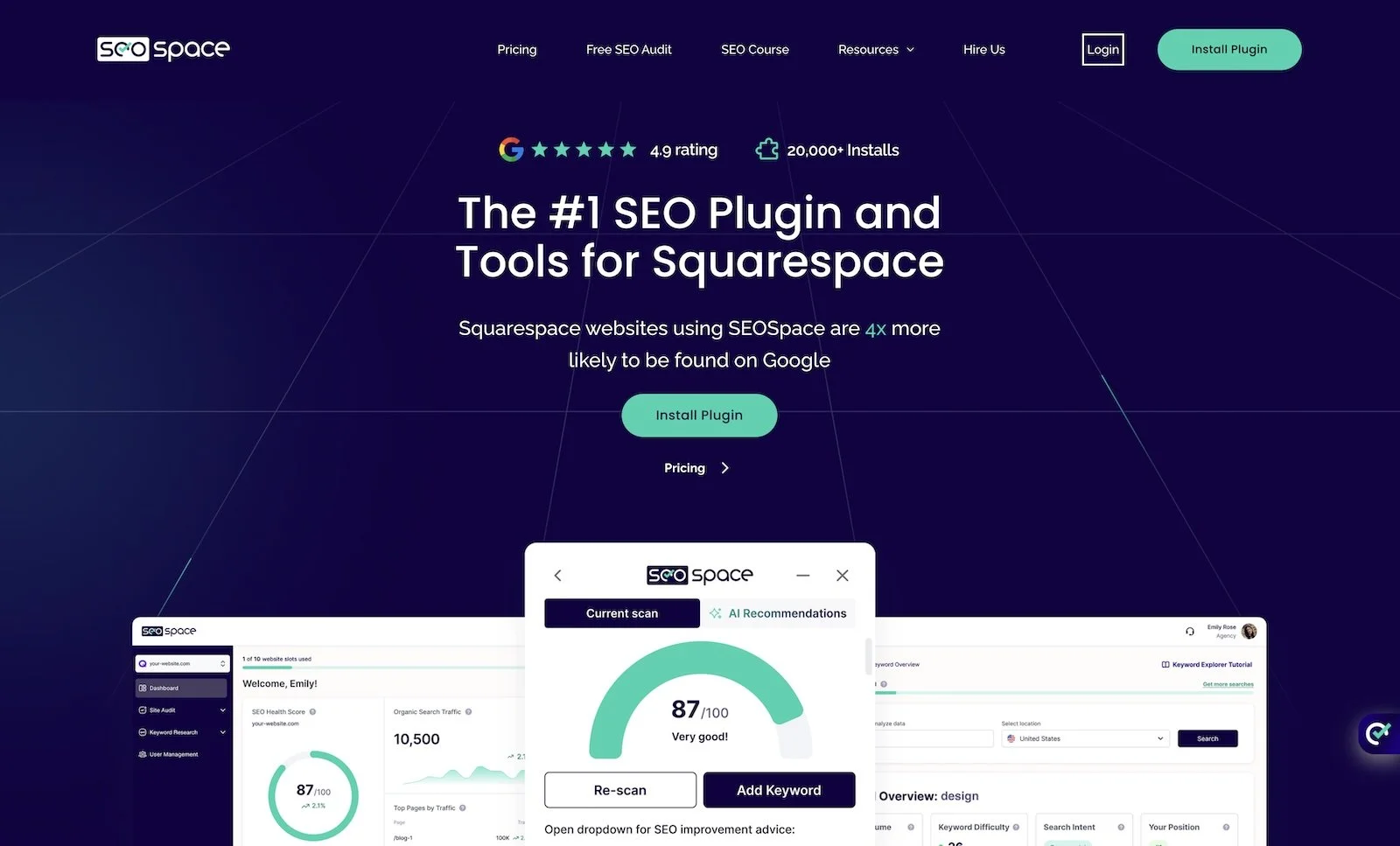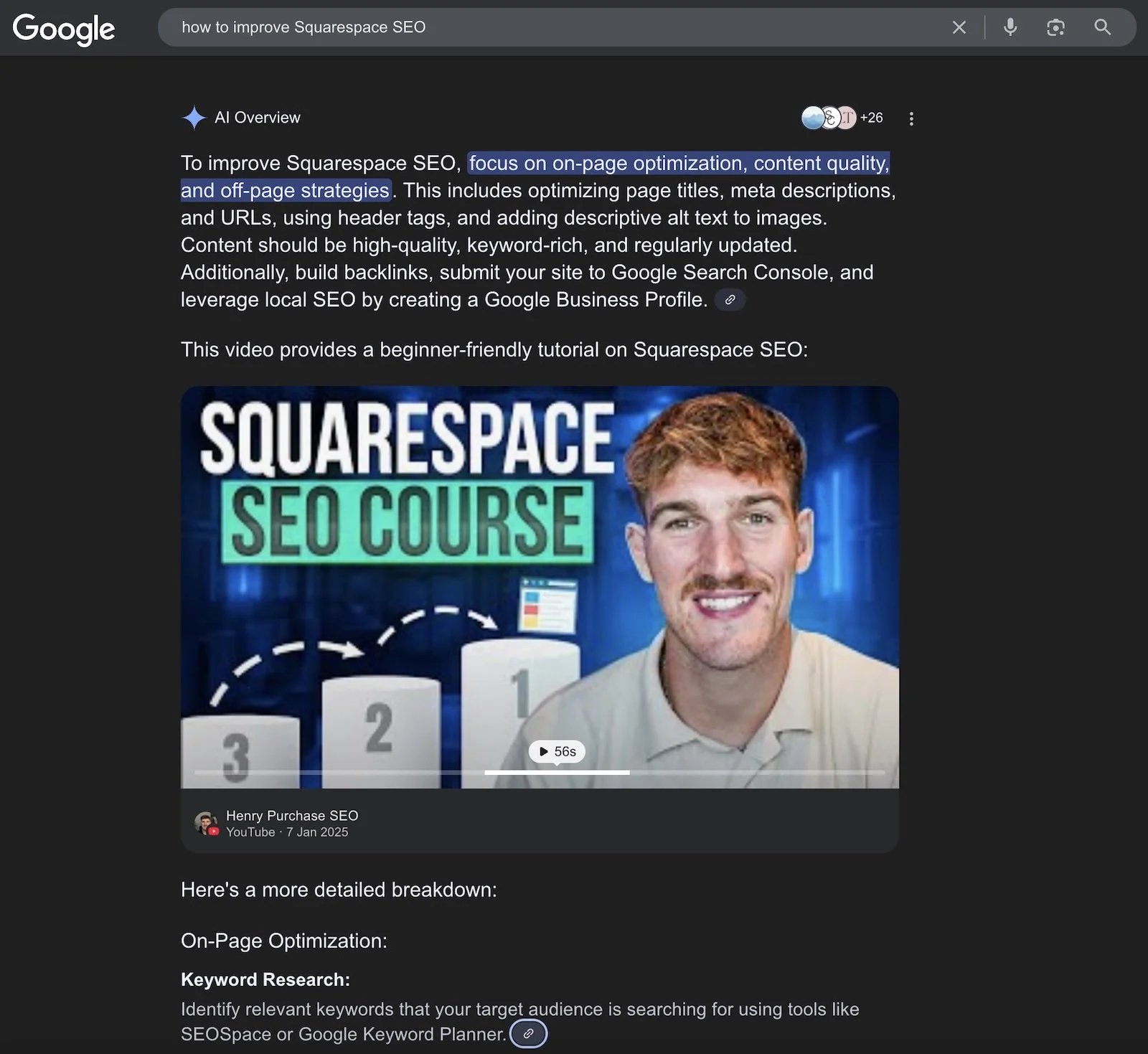The Ultimate Guide to Squarespace SEO (2025 Edition)
Squarespace SEO made simple (and a little bit magical). If you’re a soulful entrepreneur, coach, healer, or creative who poured your heart into your site—only to find it floating around the internet like a lost balloon—this is for you.
So you built your website. Lit your Palo Santo. Hit publish. And waited for the flood of dreamy clients to arrive.
Crickets.
Before you question your offer or redesign your homepage for the 87th time, hear me out:
You're not doing it wrong. You just need search engines to see you.
Squarespace isn't inherently bad for SEO. In fact, it's clean, structured, and has solid built-in foundations. But it's not magic. You need to give Google (and now AI search tools) the breadcrumbs to find you, understand you, and recommend you.
And that, my friend, is exactly what this guide will help you do.
Let’s dive in.
Table of Contents
What Is Squarespace SEO, Really?
SEO (Search Engine Optimization) is how you help search engines find, understand, and index your website—so real humans can actually discover it when they Google things like "Reiki practitioner in Lisbon" or "Squarespace templates for therapists."
With Squarespace, the good news is that:
Clean URLs, responsive design, SSL security, and sitemap are all built in
It's easy to make a beautiful, fast, mobile-friendly site
But here’s the catch:
It doesn’t do the SEO work for you (none of the builders does!)
There are fewer plugin options compared to WordPress
If you’re not intentional with structure and content, Google won’t know what your site is about (which is true for every builder)
So no, Squarespace isn’t bad for SEO. It’s just a bit of a minimalist—you need to bring the strategy.
The Essential Squarespace SEO Settings to Check First
Let’s start with the basics—the often-overlooked switches and settings that can quietly make or break your visibility. The good news? Squarespace already gives you almost everything you need to lay a strong SEO foundation. It’s got clean URLs, a responsive framework, secure hosting with built-in SSL, automatic sitemaps, and minimalistic code that loads fast and looks good on every device. But even with all that baked in, it still needs your thoughtful touch.
These are the quiet-but-crucial SEO settings to optimize right now—your first steps toward helping Google see, love, and recommend your site.
✅ Site Title & Tagline
Head to SEO > Search Appearance. This shows up in your site metadata and helps search engines know what your site is about.
If you don’t fill it in, it will be auto generated based on your content, but it’s better to be intentional about it.
Make sure you use your main keywords here.
✅ SEO Titles & Descriptions (Per Page)
Go into every page and fill in your SEO Title and SEO Description (in the gear icon > SEO tab).
Tips:
Use a primary keyword in the title
Keep SEO title under 60 characters
Make the description clear, compelling, and under 160 characters
✅ Custom Slugs
Make sure your URLs are clean and descriptive. Example: /about is better than /about-page-2-copy
✅ Indexing Check
Go to Settings > SEO and make sure the box "Hide site from search engines" is unchecked. (You’d be surprised how often this one blocks an entire site from indexing.)
✅ SSL Enabled
Go to Settings > Advanced > SSL and ensure your SSL is on. Google loves secure sites.
✅ Redirect Broken Links with URL Mapping
How to Add Keywords to Improve Your Squarespace SEO (Without Sounding Like a Robot)
Keywords are how search engines match your site to search queries. But that doesn’t mean stuffing "intuitive business coach lisbon feminine frequency" into every header. It’s so 2010.
Here’s how to use keywords the soulful way:
Where to Place Keywords:
Page titles (in both the design and SEO settings)
Headings (H1, H2, H3)
First paragraph of text
Image file names + alt text
URL slug
Meta description
How to Choose Keywords:
Use tools like Ubersuggest, LowFruits.io, or simply Google your offer and see what auto-fills.
Example:
"Squarespace SEO help"
"Reiki website template"
"How to show up on Google with Squarespace"
These longer, natural phrases ("long-tail keywords") are easier to rank for and often more aligned with how your clients actually search.
How to Structure Your Squarespace Site for SEO
Think of your website like a crystal grid. Every page carries an energetic frequency, and every link is a connection point. When your site is structured with intention, you create a seamless path for both your human visitors and Google’s bots to understand what you offer, who it’s for, and why it matters.
Search engines don’t read your website like a person—they rely on structure, relationships between pages, headings, links, and content hierarchy to piece together the big picture. If your content is scattered, hidden in images, or disconnected, you’ll struggle to gain visibility, even if your design is stunning.
The goal here is to create clarity—for humans and machines. Clarity in your navigation. Clarity in your page structure. Clarity in your content.
Let’s break it down by page type:
🌐 Homepage
Clear headline with your core keyword (what you do + who for)
Internal links to important pages
300+ words of indexable text
📖 Blog (Yes, you need one)
Each post targets a specific, preferably long-tail keyword
Write with questions in mind ("How do I...", "Best Squarespace template for...")
Add a strong intro, headings, images with alt text, and internal links
📍 Service & Product Pages
Use client-centered copy with relevant keywords
Include testimonials, FAQs, and rich descriptions
Make sure they’re crawlable (not hidden in PDFs or image-only sections)
⛓ Interlinking
Link between related blog posts
Link from blog posts to service pages and vice versa
Think of it like keeping energy flowing through your site
The Only SEO Tool Stack You’ll Need
Let’s keep it simple. Here’s a soulful and strategic Squarespace SEO tool stack that gets the job done without overwhelm:
🔍 Keyword Research
Ubersuggest – keyword ideas + difficulty
LowFruits.io – easy-win keyword opportunities
AnswerThePublic – great for FAQs and blog ideas
Google Autocomplete – free and intuitive
📊 On-Page Optimization
Hemingway Editor – simplifies your writing
Google Docs – plan content with headers and keywords
📷 Image Optimization
TinyPNG – compress images without losing quality
📊 Tracking Results
Google Search Console – see what you’re ranking for, submit your sitemap and every new page for faster indexing
Google Analytics 4 – track traffic and engagement
Squarespace Analytics – basic data right in your dashboard
🤖 Optional Extras
Google Tag Manager – for adding schema or custom tracking
Frase.io – for blog outline creation based on SERPs
🔑 Bonus: The Squarespace SEO Plugin — Made Just for Squarespace
If you want an easier way to optimize your SEO on Squarespace, especially when the built-in options feel limiting, I highly recommend SEOSpace — a plugin designed specifically for Squarespace users.
Why I Love SEOSpace (and Yes, I’m an Affiliate! ✨)
It lets you see and edit SEO titles and descriptions more efficiently
It flags missing metadata so you don’t have to click page by page
It gives you on-page optimization tips without needing a developer
It’s intuitive, lightweight, and beginner-friendly
If you’re ready to take your SEO up a notch with less tech stress, check out SEOSpace here.
(I only recommend what I use and love — pinky promise.)
Squarespace SEO in the Age of AI Search
This part is brand new—and it matters more than ever.
A quiet shift is happening in how people find answers online. If you’ve noticed that fewer people are clicking through to websites from Google, you’re not imagining it. That’s because Google is rolling out AI Overviews and a new feature called Search Generative Experience (SGE). Instead of giving users a list of ten clickable results, Google’s AI now tries to answer the question itself, right on the results page.
Imagine this: someone types in “how to improve Squarespace SEO.” Instead of scrolling through blog posts and comparing answers, they’re met with a neatly packaged summary, written by Google’s AI, drawn from a handful of "trusted" sources. Maybe a few citation links appear underneath, but often? The user finds what they need and never clicks through.
That’s what we call a zero-click search.
And here’s the kicker—if your website isn’t part of that answer, you’re invisible. Not because your content isn’t good, but because it’s not structured in a way Google’s AI can easily parse.
This isn’t just SEO anymore. This is about becoming the source—the trusted voice that AI tools reach for when summarizing the internet.
If that sounds big, don’t panic. It just means that everything you were already doing with soulful clarity and intention? It matters even more now.
Write for the human who’s searching—but build for the machine that’s answering. That’s how you stay visible in the age of AI.
🧭 How to Get Featured in AI Overviews & SGE:
Here’s how to make your Squarespace content more AI-friendly (and actually get featured):
1. Write for Clarity & Authority
Use direct questions as headings (e.g., "How do I improve SEO on Squarespace?")
Follow with short, direct answers in 1–2 sentences, then elaborate
2. Use Schema Markup
Add FAQ schema or How-To schema to blog posts
This tells search engines exactly what content lives on your page
You can add this manually with code blocks or via Google Tag Manager
3. Create Topical Clusters
Write multiple posts around the same subject (like this one + your supporting blogs)
Internally link between them so your site appears as an authority on the topic
AI tools prefer sources with depth and topical relevance
4. Be the Answer Google Wants to Show
Use formatting like bulleted lists, tables, bolded text, and short paragraphs
Cover the topic thoroughly but don’t bury your best points
Include real-world examples and up-to-date insights to stand out
5. Optimize for Voice & Intent
Many AI searches are triggered by voice: “What’s the best Squarespace SEO plugin?”
Use natural, conversational phrases that reflect how people actually speak
Common Squarespace SEO Mistakes (and How to Fix Them)
Even with the best intentions and a beautiful design, it’s surprisingly easy to overlook the little things that sabotage your Squarespace site’s visibility. I see it all the time—smart, soulful entrepreneurs who pour their hearts into their websites, only to unknowingly block search engines from finding them.
These aren’t dramatic errors; they’re tiny, sneaky oversights that can quietly hold your site back.
But the good news? They’re all fixable. Once you know what to look for, you can correct these slip-ups in minutes and start making real progress with your Squarespace SEO.
These are the things I see all the time in client sites:
"Hide site from search engines" is still checked
Go to Settings > SEO and uncheck it
All content in images (no real text)
Add real, readable, intentionally written text blocks
No internal links
Link between blog posts and service pages
All blog posts titled "New Post" or "Blog #1"
Write keyword-rich, benefit-driven titles
Alt text left blank
Describe what’s in the image using keywords
What to Do Next: Your Squarespace Website SEO Action Plan
Ready to bring more traffic, alignment, and dream clients into your orbit?
Sometimes the hardest part is simply knowing where to begin. But now you do. Whether you're just dipping your toes into SEO or ready to fully own your presence in Google’s universe, you have a clear path forward. You don’t need to do everything at once—SEO is like a garden: you plant seeds, nurture them, and trust they’ll grow. So start with one small step. Then another. Bit by bit, your website becomes not just beautiful—but discoverable.
Just Getting Started?
Let’s customize your site or template with a full SEO strategy baked in! Reach out to book a free discovery call, or here to hire a Squarespace SEO Expert! (me;)
Or explore my templates with built-in SEO-ready structure
Want to get more clients from Google? Read more about Squarespace & SEO:
SEO for Law Firm Websites: 6 High-Impact Fixes That Actually Bring Clients
SEO Keywords for Therapists: How to Find the Right Keywords to Grow Your Practice
Keywords for Vacation Rentals: How to Find and Use Them to Boost Airbnb SEO
Vacation Rental SEO Made Simple: How to Get More Bookings from Google
Squarespace SEO Review: Performance, Features & Real Results
9 Therapist Website SEO Mistakes That Are Costing You Clients
How to Add Schema Markup in Squarespace (Step-by-Step Guide)
Squarespace Web Designer Pricing: Real Costs, Packages & What’s Worth Paying For
FAQ: Squarespace SEO, Simplified
-
Nope! It's just not optimized by default. No website builder is. With a little structure and clarity, it works beautifully.
-
It will show up in Google in just a few days, if you optimize it well and submit it to Google Search Console for indexing. Climbing the rankings typically takes 3–6 months, depending on keyword difficulty, consistency, and backlinks.
-
Not necessarily. Most SEO work can be done directly in Squarespace. But plugins like SEOSpace can save time and make optimization easier.
-
You can still rank with a well-structured homepage, FAQ pages, and strategic service pages. But blogging helps a lot.
-
If you're a DIYer with time, go for it! If you want to fast-track results or feel stuck, book a session and I’ll help.

